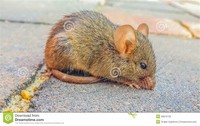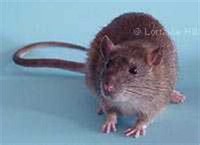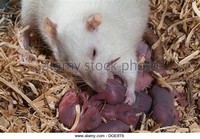Facts about Rat

Pet rats, also called "fancy rats" (from the expression "rat fancy," not because the rats themselves are fancy in appearance), continue to be very popular.

Other damage caused by rats includes damaging dams and irrigation works by burrowing, causing power outages and fires by gnawing electric wires, contaminating food, damaging furniture and many other things.

When the disease spreads to commensal rats, especially the black rat, humans can be infected.

Some species of rats, both true rats and rats of other genera, have become very successful by taking advantage of human activities.

From time to time, a white or spotted rat would be born due to genetic mutation.

Rats generally have bodies longer than 12 cm (five inches), and mice are similar looking animals that are perhaps 12 cm or less in size.

True rats are opportunistic feeders, eating seeds, fruit, vegetables, insects, other small animals.

Rodents referred to as both rats and mice can be found in the families Cricetidae, Nesomyidae, Spalacidae, and Muridae.

The brown rat, R. norvegicus, also known as the Norway rat and the sewer rat, is a ground dweller and naturally digs its burrows near water.

The marmoset rat of southeast Asia (Hapalomys longicaudatus) feeds mainly on bamboo and builds its nests in the bamboo stems (Nowak 1986).

The black rat, which was introduced to many remote islands by early sailing ships, is listed as one of the world's 100 worst invasive species by the Invasive Species Specialist Group (ISSG 2007).

Most true rats live in forests or near rivers or other bodies of water.

Among the largest rat species are the muskrat of North America (Ondatra zibethicus), which weighs 700 to 1800 grams (1.5 to 4 lbs) and the giant tree rat of New Guinea (Mallomys rothschildi).

Rats, like all mammals, are edible by humans and are sometimes captured and eaten in emergency situations.

Kangaroo rats of North America (Dipodomys species) live in desert environments and do not need to drink; they get the water they need from the seeds and insects they eat.

Rats are various medium sized rodents, similar in appearance to mice, but larger.

Rats typically have a four or five fingered hand, whiskers which serve as sense organs, and a long tail, which in most species is hairless.

Most rats are omnivores, eating both plant and animal foods, and generalists, not bound to one specialized way of life.

In 1895, Clark University in Worcester, Massachusetts (United States) established a population of domestic white brown rats to study the effects of diet, and for other physiological studies.

Rats can carry over thirty different diseases dangerous to humans, including Weil's disease, typhus, salmonella, and bubonic plague.

Like most smaller rodents, true rats and most other rats mature rapidly and only live for a short time.

Professional rat-catchers can be found in many developing countries and rat control is a big business world-wide.

The fish-eating rats of South America (Ichthyomys species) swim in streams to catch small fish.

Laboratory rats have also proved valuable in psychological studies of learning and other mental processes (Barnett 2001).

Part of the difficulty is that some rat species, notably the black rat, have been spread by humans as invasive species into non-native habitats.

Rats fight to establish dominance within the group, but rarely kill or injure each other.

A variety of rat control methods have been used throughout human history to either reduce or eliminate rat populations in homes, markets, farms, and industrial sites.

Squirrels of most species are about the same size as rats but are members of their own rodent family, Sciuridae, and are usually more specialized than rats.

The domestication of rats started in England with the sport of rat-baiting, in which rats (mostly brown rats) were put into a pit and killed by dogs.

Some species of rats, both true rats and rats of other genera, have become very successful by taking advantage of human activities.

The black rat reaches sexual maturity in 80 days; its longest recorded life was four years and two months (Nowak 1986).

Bandicoot rats are an important food source among some peoples in India and Southeast Asia.
4 A female rat can mate as many as 500 times with various males during a six-hour period of receptivity—a state she experiences about 15 times per year. Thus a pair of brown rats can produce as many as 2,000 descendants in a year if left to breed unchecked. (A rat matures sexually at age three to four months.)Dec 7, 2006
remote access Trojan
Rats are often associated with filth and disease. So, if someone calls you a rat, it's not like being called a fox. ... These negative traits have led to the informal meaning of rat, "hateful person," "liar," or "double-crosser." You can also use rat as a verb to mean "betray or snitch on."
Adult mice, on the other hand, will have adult proportions: a small, triangular head with a small nose and little delicate feet as compared to the body. In addition, mouse ears are very large relative to their heads, rat ears are smaller relative to their heads. Rats also have thicker tails than mice.
The term "rat" is also used in the names of other small mammals which are not true rats. ... Male rats are called bucks, unmated females are called does, pregnant or parent females are called dams, and infants are called kittens or pups. A group of rats is referred to as a mischief.








